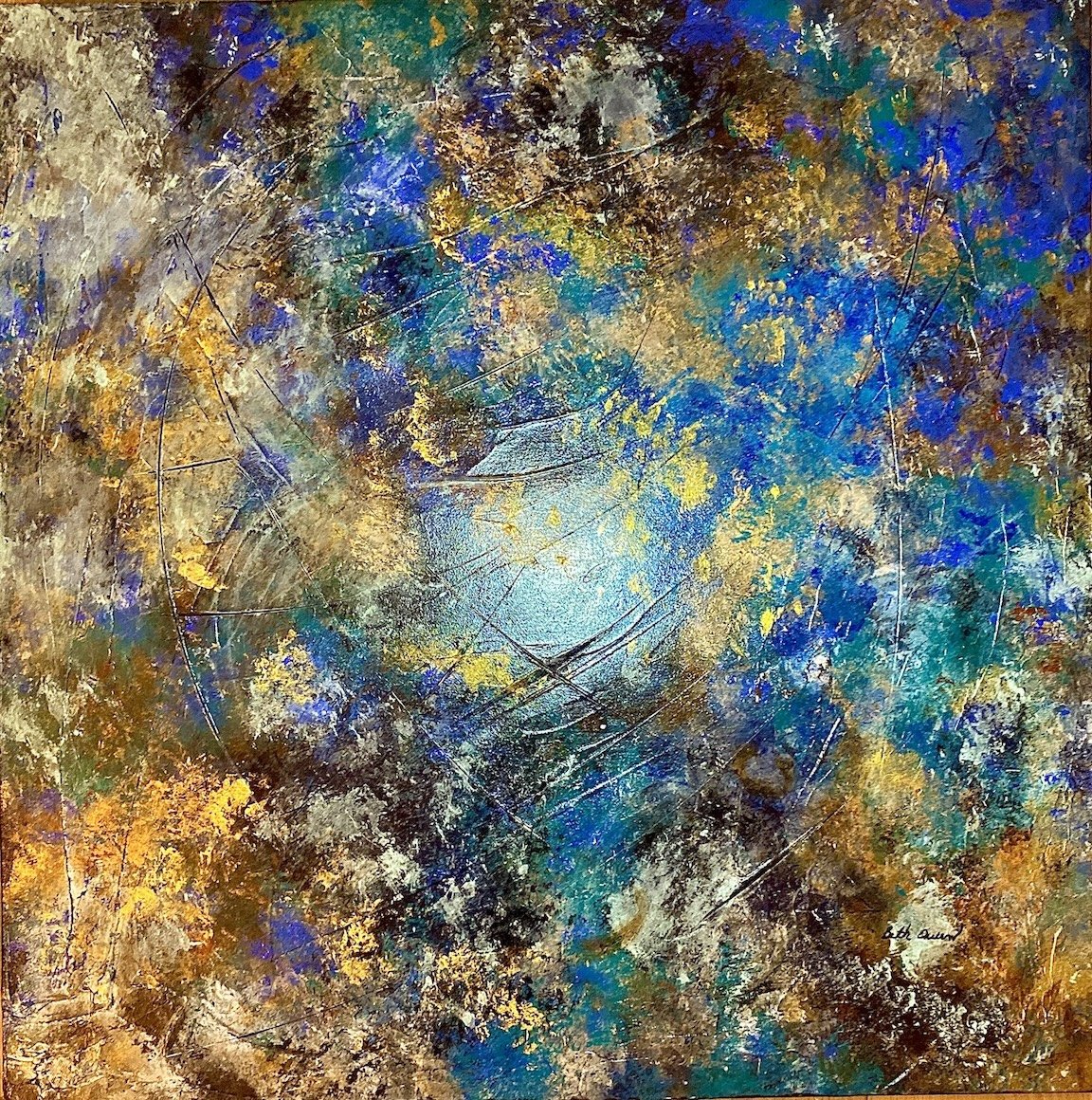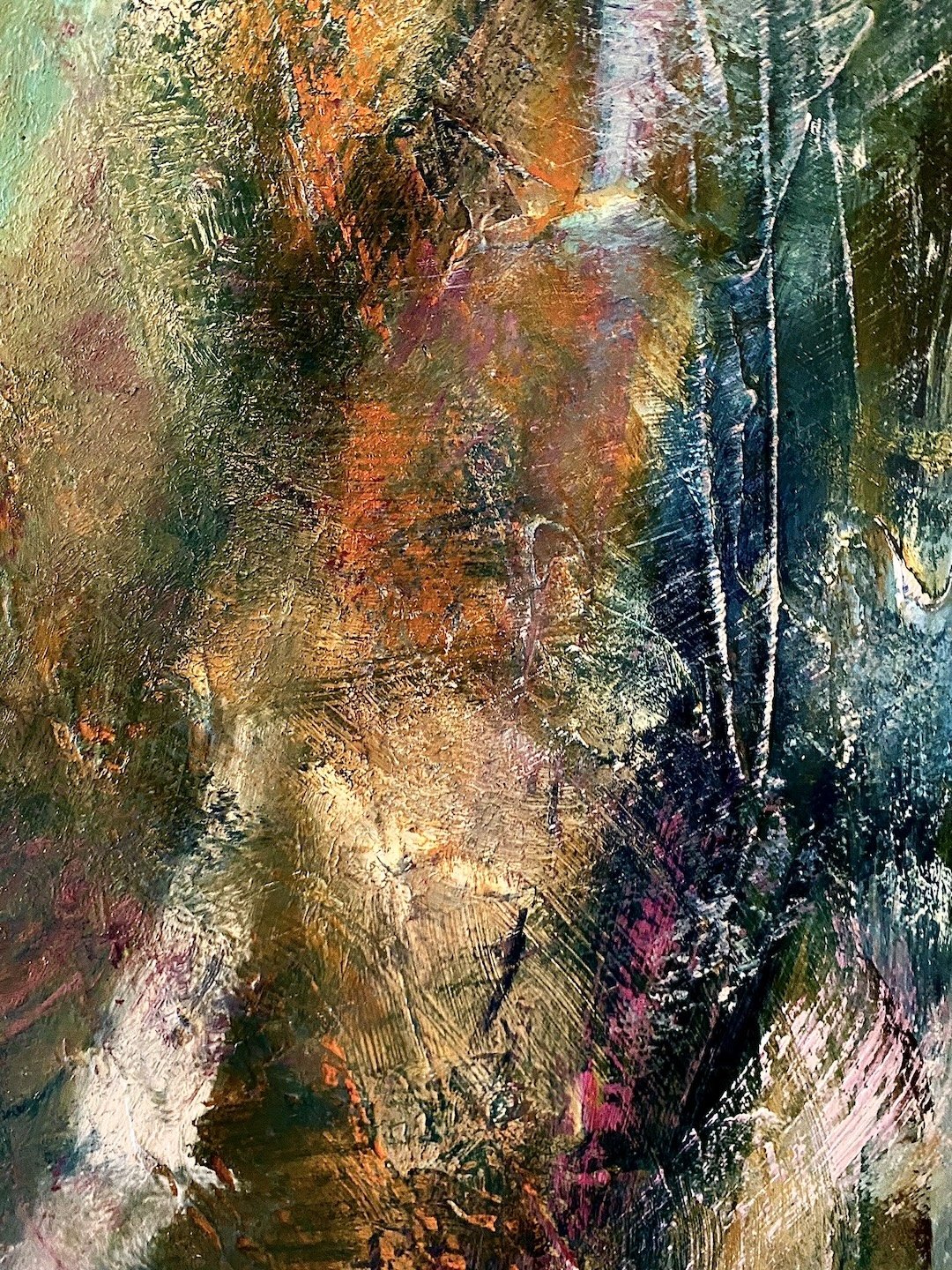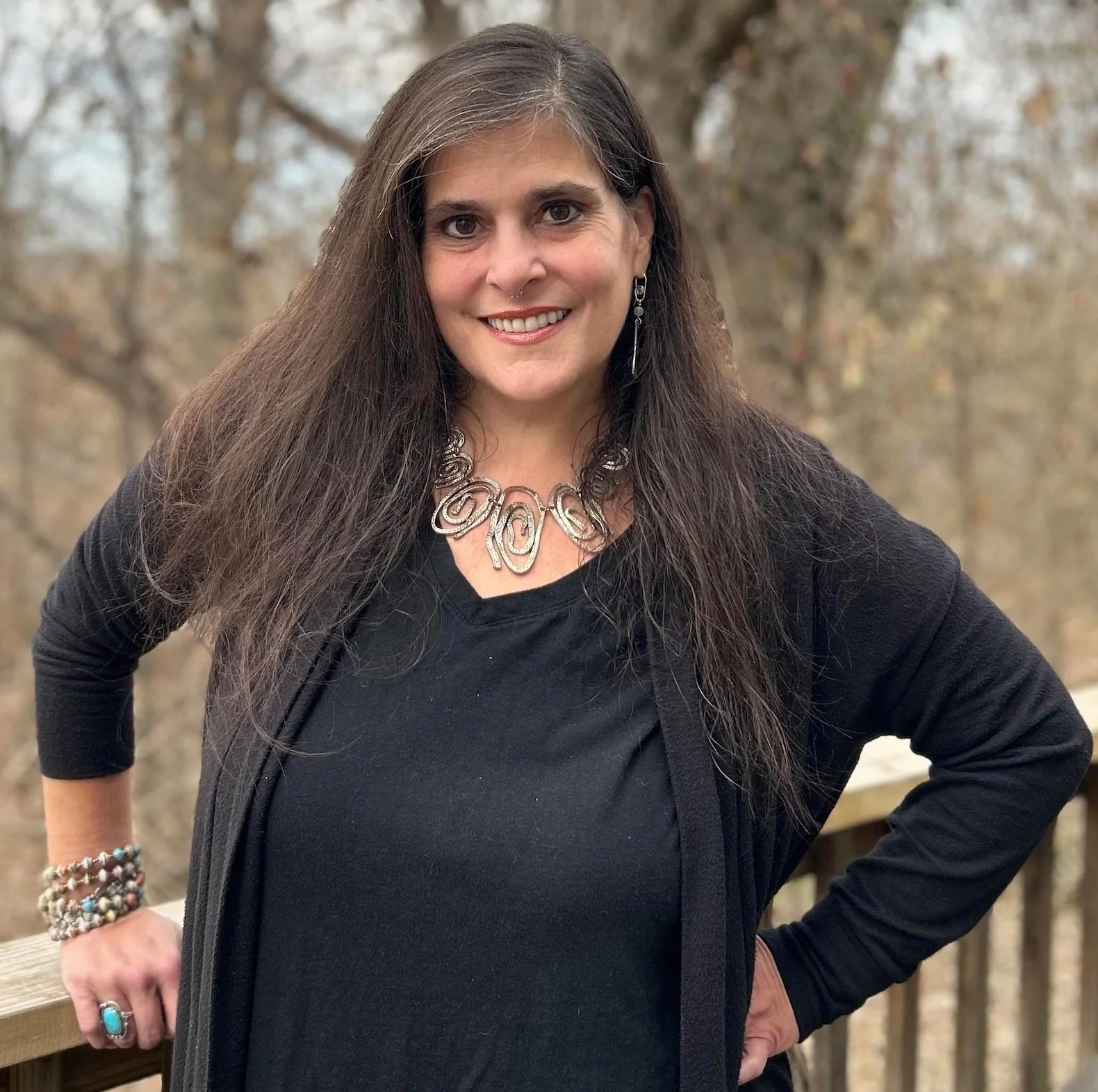Interview with artist Beth Owen
Beth Owen is an Arkansas native living in Fayetteville. She earned a degree in art history from the University of Arkansas and admits that it was her studies that got her interested in abstract art as a way to express personal emotions. More of Beth’s work can be found at her Instagram.


AAS: Beth, where did you grow up?
BO: I was born and raised in El Dorado, Arkansas, a small town in South Arkansas about 15 miles north of the Louisiana border. I graduated from El Dorado High School. El Dorado was a boom town a little over a hundred years ago because oil was discovered there in 1921. The 1987 recession hit my family hard as my father was in automotive sales. In 1993, the entire family decided to move to Northwest Arkansas. I have lived in Fayetteville for the last 31 years, 23 years of those have been with my husband, Kirk. In 2015, I graduated from the University of Arkansas with a BA in Art History.
AAS: Was art an important part of your life growing up?
BO: Art was a central part of my upbringing. Both my mother and maternal grandfather were artists. For the first four years of my life, my parents and I lived with my grandparents. I remember watching almost in a hypnotic trance my mother paint in her little studio. At some point my grandfather, affectionately called Daddy D (last name was Daughtridge), scooped me up and put me in his lap and taught me to draw and paint. I loved it! I remember drawing faces of ladies with over stylized tulip lips and hairstyles from the 40’s, but that was my grandfather’s generation. He was a veteran of WWII, having been at D-Day and The Battle of the Bulge. Art was therapy for him. He painted overseas during his downtime. Materials were hard to come by, so I think they were provided tempera paints or perhaps something like gouache in the field. I still have one of his paintings he created during WWII.
I loved many art forms growing up from music, theater, literature, to ballet. I even considered a career in ballet when I was in junior and senior high school. But by the time I graduated from high school, I decided I wanted more of a normal life, so I went back to my first love of visual art.
AAS: What is it about abstract art that excites you?
Dance!, 36" x 24", oil and impasto medium on canvas
BO: While I am certainly appreciative and love many genres of art, I became interested in abstraction when I was working on my art history degree at the University of Arkansas. Learning about the emotional impact of how World War II and the atomic age changed so many artistic styles of artists like Rothko, Pollock, De Kooning, and the women of abstract expressionism like Lee Krasner, Helen Frankenthaler, Joan Mitchell, and others. It really hit home with me. I experienced true loss and grief when I was nine years old when I lost my beloved grandmother. The huge pain I felt from that experience, as I look back on it now, propelled me forward. I learned coping skills. The summer after her death when I was in 3rd grade, I won my first art contest. The prize was free art lessons from The South Arkansas Arts Center. A few years ago, I lost my mom in 2019. I went into a major depression for a few months. Finally, a voice inside me said, “Get up! Go and buy some art supplies and paint.” I went and purchased some oil paints as it had been several years since I had worked in oil. I watched YouTube videos as refresher courses on using oil paints and the new mediums that had come out since I last used oil. I created one of the best abstract artworks I’ve ever created, I call Dance! My mom LOVED to dance. It’s an amalgamation of various oil colors and impasto medium that I made with a palette knife onto a red background.
AAS: Tell me about Am I Blue and your cold wax technique.
Am I Blue, 30" x 40", oil and cold wax on canvas
BO: When mom passed, and I was learning new oil techniques and mediums, I researched cold wax. I loved the aesthetic. Immediately after my mom died, my dad started going downhill quickly. He had a mild stroke, so I became his daily caregiver for four years. I loved my dad, and I think I was always something of a daddy’s girl all my life. But caring for a loved one takes its emotional toll on family members despite how much love one has. When I would finish my care for my dad, I would come home and paint. Incorporating the cold wax as a medium with the oil paint, allowed me more of the expressive outlet I really wanted to convey. It’s a dense encaustic medium. It lets me dig, scrape, and slash at my pieces; to vent my negative feelings onto a canvas.
Because of popular culture, we attribute the color “blue” with sadness. I knew I was losing my dad because every year until his death in August of 2023, he was getting worse. For me, I visualize grief through an assortment of colors depending on the stage of grief we go through; red being the angry stage, white as numb, and yellows as that phase of acceptance. I love the color blue. For me, it’s a color of rebirth, renewal, and peace. So, with this particular piece, I could express myself with the various colors as initial layers, but the cold wax would allow me to “peel” back the surface layers of blue; my color of healing, to the reds, yellows, violets, etc. that make up all the other emotions that come with grief. So, the title “Am I Blue” is asking me the question, am I sad, or is this some other emotion that makes me feel sad.
AAS: You mentioned the study of art history. How do you think studying art history has directly influenced your abstracts?
BO: It definitely had an impact. Studying art history allowed me to really understand the political and cultural aspects of the time – the historical context of artists who came before us. And, yet my specialty wasn’t the Italian Renaissance or the Dutch masters. I became fascinated with the art and culture of Pre-Colombian Mesoamérica; the Aztecs and Maya. In fact, I had my sights on graduate school so I could study Mesoamerican art history and eventually teach it. However, when I finished my BA, I was tired. But the passion for continuing to study this thrilling culture is always in me. The rich organic colors found in the ancient codices and ceramics from those cultures can be found in my own art. I will use red and yellow ochres, obsidian and jade greens, and brilliant blues to achieve that elusive Maya blue in my own art. Ancient cultures in general have a strong influence on my art but primarily those of ancient Mesoamérica.
AAS: Mystic Valley is an abstracted landscape. When you begin to work on a painting are you fairly confident about how it will turn out? Are your colors and techniques predetermined?
Mystic Valley, 24" x 18", oil and cold wax on canvas
BO: I think all my works are to a degree, pre-determined. However, that’s not to say I won’t change course in the middle of a piece and go in a different direction than originally planned. I can want a certain aesthetic starting out, but how I achieve that look can often be spontaneous. But Mystic Valley was always pre-determined from the beginning. I love the colors of the southwest as I spent some time in Arizona many years ago. It’s not so much the traditional southwest colors but that of the colors seen in the desert at dawn or dusk. Those majestic purples, burgundies and pinks combined with blues and greens. I wanted to convey that image without it being overtly thought of as a landscape. I also wanted to achieve an older aesthetic like something out of an old Italian renaissance mural in a fresco technique. That’s where the actual texture of the piece is conveyed utilizing a light layer of modeling paste and allowing it to dry completely before applying the oil paints.
AAS: Even though En Pointe is filled with movement, it has a comforting or soothing quality. Tell me about it.
En Pointe, 36" x 24", oil and cold wax on canvas
BO: En Pointe definitely stems from a happy memory – my years in ballet. I wanted to convey movement with bright pastel colors often found in ballet costumes. The movement comes from again adding cold wax to the oil paint. I wanted the story behind this piece to be as special as the memory is. Therefore, I took one of my old ballet toe shoes and covered the end of it in plastic wrap to protect it. The ultramarine blue marks you see that convey movement are not made with a brush, but the toe (the box) of my ballet shoe. The marks represent the marks dancers leave on stage from having stepped in the resin box (offstage) right before they appear onstage, so they don’t slip. The resin allows dancers to “grip the floor” better.
AAS: Existence has wonderful texture, which conveys almost chaotic movement. Tell me about that piece and how you accomplished that look.
Existence, 24" x 18", acrylic and modeling paste on canvas
BO: I suffer from insomnia quite a bit, especially when I was caring for my dad and immediately after his death. I wanted to convey the frenetic mood I was in. Rather than use traditional modeling paste, I decided to use plaster patch so I could carve a little deeper into the medium while it was wet with my trowel shaped palette knife. After it dried, I painted the entire canvas black before I started putting the color in. I decided to include basic colors that represent the ancient elements of earth, fire, air, and water with reds, umbers, blues, and white. Again, I did not use a brush as I wanted to almost “beat” the colors in with paper towels. I love working with paper towels to achieve frenetic, chaotic movements.
AAS: Tell me about the documentary film project you are working on featuring artists in NWA.
BO: COVID had a tremendous negative impact on art markets everywhere. But COVID also allowed for artists to emerge since we were confined to home that initial year. I am a person who was raised that personal success comes from bringing others along with you. I am quite fortunate to have other artists from this area welcome me to this art community with open arms. There is a saying that artists only spend 20% of their time creating and the remainder marketing themselves. This is so true! I kept thinking how this art community could succeed and really start bouncing back from the negative impact COVID had on us as well as the galleries and museums. My friend, Dr. John Sutherlin who is from my hometown of El Dorado, Arkansas, is a professor of political science at the University of Louisiana at Monroe. He has also made several “awareness” type documentaries, his most recent “Freeman” has won several awards from Portugal, Toronto, and the Touchstone documentary award. “Freeman” is about the trials and tribulations of a Drag Queen from northern Louisiana. It’s a great documentary that should be watched by everyone as it tells a story of forgiveness and giving. So, I thought why not make a documentary about what artists in this area go through on a daily, monthly, and yearly basis as we apply for grants, juried art calls and try to get our works in galleries. So Zeek Taylor, Tom Flynn, Rachel Ann Kendrick, Melissa McCutcheon, Karolyn Farrell, and Marsha Lane Foster had a zoom call with John to see how we go about getting started. John is thrilled to do such a documentary so now the task of getting the funds together to make it are in play. It will take us probably two or three years to make it, but this group of artists is determined to make it happen. We’ll start writing grants and soliciting donations from private sources with a hope to have Crystal Bridges Museum of American Art premier it. I would love to make this happen.
AAS: You’ve really only been painting seriously for a few years. What have you learned about the art you want to create and about yourself during this time?
BO: One thing I have learned is you have to be unique. When showing some of my pieces to a gallery owner and curator, he said I have pieces like those, but he pointed to Existence and another one, and said, “That! I want you to do more of that!” So now I have three galleries in Northwest Arkansas wanting to include some of my works in their galleries. This art community is great. If it wasn’t for Mason Holcomb, an artist and former curator at Art Ventures Gallery, I probably wouldn’t be doing this. He saw something in me and kept encouraging me to make larger and larger works where now, the smallest piece I will even want to do is a 20” x 20”. Amy Eichler is a walking source of information about the business side of art. Amy, Shabana Kauser, Cheryl Keller, Karolyn Farrell, Melissa McCutcheon, Marsha Lane Foster, and Jim Foreman of The Art Collective have all been HUGE sources of inspiration. But I owe so much to my family; especially my husband, Kirk, for working so hard, paying the bills, and believing in me. Everything I make from art sales goes right back into my business, Beth Owen Art. If my parents were still here, I know they would be so proud of me. The last thing my dad said to me before he went to hospice care was, “You go do you, now.”




